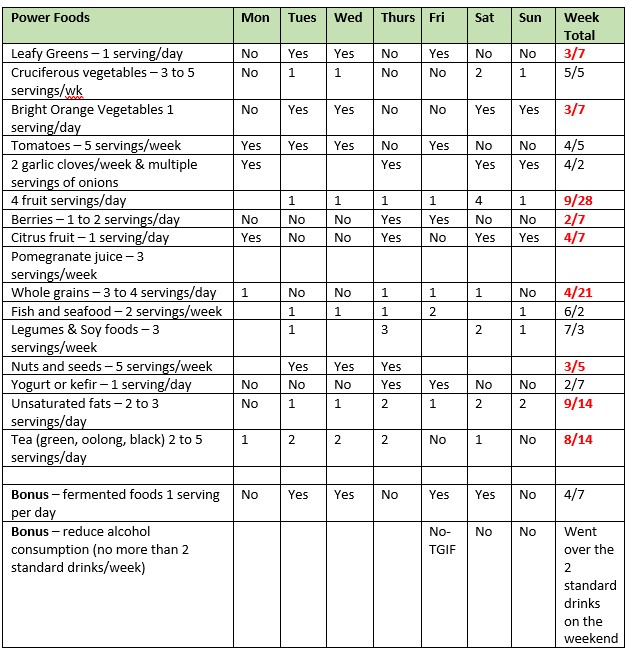Eating 7-10 Servings of Vegetables and Fruits per Day Takes Planning
If you remember from last month’s aging well blog, on the topic of nutrition, it was recommended to increase your intake of vegetables and fruit to 7-10 servings per day.
I did not meet this goal!
This goal can be achieved, but it takes a lot of planning and making sure you have all the groceries you need to succeed.
I did pretty good the first week after I had bought the food that I needed, but then I got busy with a consulting project that was a rush job and everything went off the rails! I focused on work and let other things slide. Plus, I was trying to organize a 6-week trip out to the Maritime’s.
I justified my slacking off with the fruits and vegetables with, “I’ll never get everything done if I waste time on the aging well project.” Probably not the right attitude for nutrition success!
Here are the results. (I’ll show just show one week of results (April 10 to 16) as it is reflective of the other weeks.

Tracking Your Food Against Recommended Servings of Nutritional Groups Does Give You Valuable Insights
Although I was unsuccessful in meeting a lot of the recommended servings for each food category, I do consider the experiment a success.
By looking at the recommended servings and keeping track of what I was eating, I became more aware of where I am following short on nutrition. I found this interesting and beneficial.
For example, I am doing really well in the servings of fish/seafood, but not well in getting enough whole grains per week. I really need to up the grains! What are the grains that are good for you?
- Amaranth
- Barley
- Brown Rice
- Buckwheat
- Flaxseed
- Kamut
- Millet (hulled)
- Oats
- Quinoa
- Rye
- Spelt
- Whole Wheat
- Wild Rice.
The other category that I am finding it difficult to have enough servings is with fruit. Having 4 servings a day is a lot of fruit. We are coming into the spring/summer season, so this should become easier to buy fruit. I will try again once I came back from the Maritimes in June.
Other Experiments That You Can Try
If your diet does not make you feel energized and satisfied, you can challenge yourself with ideas from the Internet. Consider the following challenges where you can either modify unhealthy habits or build healthy habits, for example, by adding wholesome foods into your diet.
No Sugar Challenge
Excess sugar consumption has increased dramatically over the past 20-30 years and has been shown to have several detrimental side effects including obesity, dental decay, cardiovascular disease, diabetes, liver disease, dementia, and depression (Schmidt, 2014) (Hu et al., 2019). Decreasing your sugar consumption is an excellent way to improve your health.
For 30 days, try cutting out all processed sugar from your diet. This includes sugar-sweetened drinks, cookies, cake, and other sugary foods. Try replacing sugary snacks with naturally sweet foods such as fruit or honey.
Veggie-A-Day Challenge
This challenge will help you introduce more wholesome foods into your lifestyle. Eating more vegetables is an easy way to get more nutrients, fiber, and variety in your diet. A good rule of thumb is that for each meal, your plate should be ½ vegetables, ¼ carbohydrates, and ¼ protein. If you are not used to eating that many veggies try adding them to just one meal per day, every day for 30 days, and see if you notice improvements in the way you feel.*
I have not tried these challenges, but it is ‘food for thought’. I think the ‘no sugar challenge’ would be difficult, but let me know if you try it and how you felt during the process.
Well that’s a wrap!

Live and eat well.

*https://www.berkeleywellbeing.com/30-day- challenges.html
